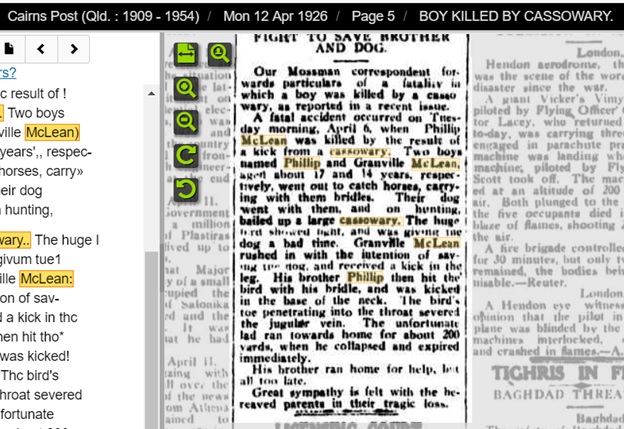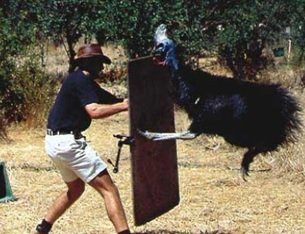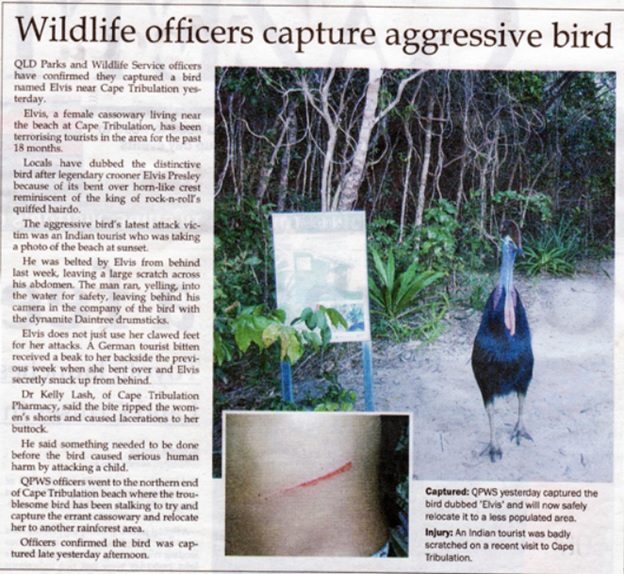How Dangerous is the Cassowary? (Bailed up by Cassowaries at Mount Hypipamee National Park)
A few weeks ago (January 20th) I had the most amazing experience with cassowaries. Our historical society group of four stumbled upon a group of five birds; two males looking after three chicks. One male immediately loped towards us, sending us scurrying to hide behind trees. We were held hostage for about 10 minutes while he checked us out, and then they finally ran off.
For those who know the area, the cassowaries were on the old Herberton Road, near the carpark.
So how dangerous are cassowaries?
First up; horses result in the most Australian animal-related deaths, followed by cows and dogs. 254 animal related deaths in a 10 year study recorded 137 deaths from horses, cows and dogs. Then 18 kangaroo related deaths, (mostly due to car accidents, 16 each by sharks and bees, 14 snake bite deaths, and 9 crocodile attack fatalities. There were 5 emu related deaths, all from car accidents.
The most likely way to die from an interaction with a cassowary would be crashing into one with your car. (Over one thousand people die every year in Australia in road crashes. Also there are over 250 murders per year in Australia, if we count humans as dangerous animals!)
So why the deadly reputation? Cassowaries are intimidating birds … they are big (third tallest bird in world and second heaviest), and they are one of the few birds actually known to have killed people. They are also known for frequent and severe attacks on zoo keepers, and they have also killed other animals, including horses.
Despite the array of scary birds, (I remember being terrified as a kid of dive bombing magpies), birds are not normally people killers. Recent exceptions include:
The defense in a 2003 North Carolina murder case involved a barred owl getting caught in the victim’s hair (Kathleen Peterson), before she fell down stairs and broke her neck. It was never actually presented in court, and was not ever said to be the actual cause of death. Author husband Michael was jailed but later released for time served after a plea bargain for a lesser charge of manslaughter.
A chicken that killed Indian Singrai Soren, in December 2010, and one that killed Californian Jose Luis Ochoa, in January 2011. Both were killed by roosters that were fitted with metal spurs for cockfighting. Police raided an illegal cockfight near Bakersfield, Central California and all the gamblers and onlookers fled – leaving 5 dead roosters. Two hours later Jose Luis Ochoa was pronounced dead at the hospital; as he fled a rooster attacked him and he bled to death from a wound to the right calf. Ochoa had previously been fined $370 for owning or training an animal for fighting. Singrai Soren was killed by a rooster he had bought at a fair 4 months earlier; it had already won 4 fights, before he went to Mohanpur Village for their famous cockfight. The rooster won the first fight, but was reluctant to enter the ring for another fight (normally roosters are rested for at least an hour, but Singrai was intent on getting another quick win – the prize being the opposition rooster to eat). As he tried to force the rooster back in the ring, it lashed out and cut his jugular vein. Both men were aged 35.
Male ostriches are very territorial during mating season. In 1997, sixty-three year old, Anna (Ouma) Hendricks was crossing an ostrich farm, near Cape Town, South Africa with her husband; both were hospitalized, but Anna died two weeks later of her injuries. Husband Abraham, incapacitated, had watched Anna being stomped for about an hour. In 1999, eighty-one year old, Fred W. Parker died from a broken neck after getting in the pen with the ostrich, King Tut, at Winlock, Washington. A ninety year old Louisiana farmer, in 2000, died and his wife was critically injured when attacked by a male ostrich, protecting three females.
Scottish silent movie star, Billie Ritchie (whose drunken tramp character, Charlie Chaplin is said to have copied) was attacked on a movie set by ostriches, and spent the next 2 years confined to bed, dying 6 July 1921 from stomach cancer said to be related to his injuries. (In 1981, Celebrity Johnny Cash was famously attacked by ostriches on his ranch.)
And then there is one confirmed cassowary related death – in April 1926, at Mossman, north of Cairns, Far North Queensland: Phillip McLean died after receiving an injury to the throat. He had tried to protect his dog, which was being attacked.

The Cairns Post article is likely to be closer to the truth than the following typical internet account, as Mossman is close to Cairns.
The one documented human death was caused by a cassowary on 6 April 1926. 16-year-old Phillip McClean and his brother, aged 13, came across a cassowary on their property and decided to try to kill it by striking it with clubs. The bird kicked the younger boy, who fell and ran away as his older brother struck the bird. The older McClean then tripped and fell to the ground. While he was on the ground the cassowary kicked him in the neck, opening a 1.25 cm (0.49 in) wound which may have severed his jugular vein. The boy died of his injuries shortly afterwards.
On the internet you can also find the unconfirmed death of a zookeeper named Luke James who was apparently killed by a captive cassowary. Perhaps this relates to a San Francisco Zoo worker injured in February 2001 when a 5 year old male cassowary attacked him and slashed his leg open. A man and his mother are also supposed to have been killed in a Papua New Guinea village when a captive-raised bird returned and wreaked havoc. (Spears in Papua were made with the cassowary claw as the tip, and Papuans tell stories of disembowelment by cassowaries.)
Certainly cassowaries do occasionally attack people. At the Babinda Boulders, in April 2012, tourist Dennis Ward encountered a cassowary that kicked him off the cliff and into the water. 
In April of 1995, Doon McColl was jogging along the Mt Whitfield trail, Cairns, when she heard a noise behind her. She turned to see a full size adult cassowary running after her, so she ran and climbed a tree. The big bird waited below for hours and finally wandered off. A week later her boyfriend, Ray Willetts, was also chased. He tried to lose the bird in the jungle and spent the day crashing through thorns and lawyer cane while the huge bird followed effortlessly. (In 1996, this 30 year old female, nicknamed Blue Arrow after the track, was killed by dogs, and there are no longer cassowaries in this area).
At Mount Sorrow, Cape Tribulation, a tourist couple were on the way down when they were chased by a large cassowary. When all attempts to shake off the bird, or to stand their ground failed, they laid down in the mud and played dead. This calmed the bird, which had been hissing and breathing heavily before. Unfortunately the bird then sat down next to them and kept them prisoner; every time they made the slightest move the cassowary would get up and make threatening moves again. After about 40 minutes of being detained, two other hikers came past on the track and the cassowary got up and went after them! The lucky couple got up and rapidly made their way down the hill.

A 2003 historical study of 221 cassowary attacks showed that 150 had been against humans. 75% of these had been from cassowaries that had been fed by people. 71% of the time the bird had chased or charged the victim. 15% of the time they kicked. Of the attacks, 73% involved the birds expecting or snatching food, 5% involved defending natural food sources, 15% involved defending themselves from attack, and 7% involved defending their chicks or eggs. The 150 attacks included only one human death.
As you can see, most of what people call attacks, are individuals being approached, followed or charged. Cassowaries can run much faster than a human; if they want to catch you, they will, but they seem to enjoy chasing fleeing people. A better strategy is to stand your ground, look as tall as possible (hands above your head) and have an object between yourself and the bird. Crouching, turning your back, or laying on the ground are generally NOT good ideas. Stay calm and back away slowly.
Do a search for cassowary to see other Steemit articles on the cassowary, or check out some references I used:
https://blogs.scientificamerican.com/tetrapod-zoology/how-dangerous-are-cassowaries-really/
http://www.australiangeographic.com.au/topics/wildlife/2016/03/here-are-the-animals-really-most-likely-to-kill-you-in-australia/
http://www.amazingaustralia.com.au/animals/cassowary-attacks.htm
Also check out Youtube video Big bird attacks person - cassowary (not a pretty sight)
Congratulations, Your Post Has Been Added To The Steemit Worldmap!
Author link: http://steemitworldmap.com?author=tropictopics
Post link: http://steemitworldmap.com?post=how-dangerous-is-the-cassowary-bailed-up-by-cassowaries-at-mount-hypipamee-national-park
Want to have your post on the map too?